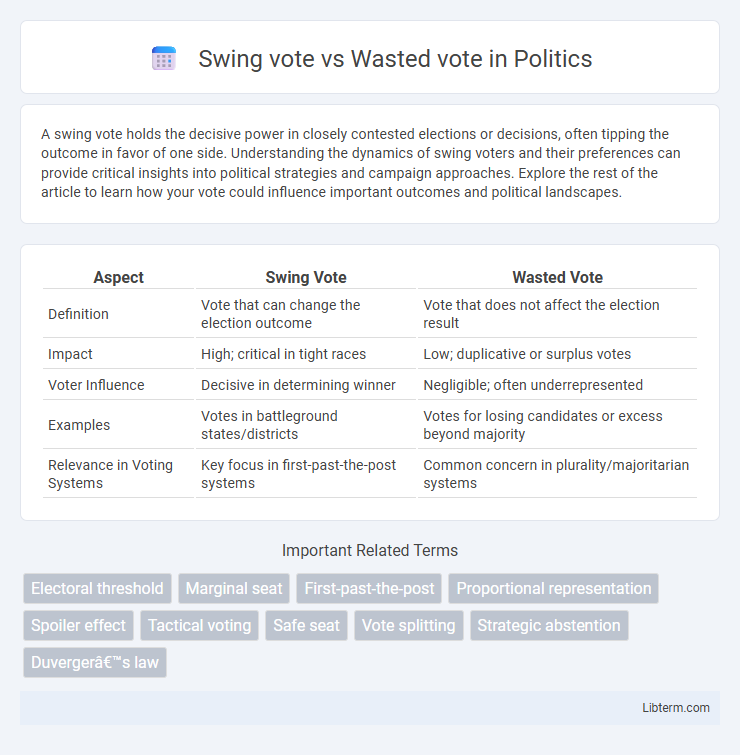A swing vote holds the decisive power in closely contested elections or decisions, often tipping the outcome in favor of one side. Understanding the dynamics of swing voters and their preferences can provide critical insights into political strategies and campaign approaches. Explore the rest of the article to learn how your vote could influence important outcomes and political landscapes.
Table of Comparison
| Aspect | Swing Vote | Wasted Vote |
|---|---|---|
| Definition | Vote that can change the election outcome | Vote that does not affect the election result |
| Impact | High; critical in tight races | Low; duplicative or surplus votes |
| Voter Influence | Decisive in determining winner | Negligible; often underrepresented |
| Examples | Votes in battleground states/districts | Votes for losing candidates or excess beyond majority |
| Relevance in Voting Systems | Key focus in first-past-the-post systems | Common concern in plurality/majoritarian systems |
Introduction: Understanding Swing and Wasted Votes
Swing votes represent the crucial, undecided ballots that can determine election outcomes by shifting the balance between candidates. Wasted votes occur when ballots either exceed the threshold needed for victory or are cast for losing candidates, thus having minimal impact on the final result. Understanding the distinction between swing and wasted votes is essential for analyzing electoral strategies and voter behavior.
Defining the Swing Vote
The swing vote refers to a critical vote in an election or decision-making process that has the power to change the outcome by shifting the balance between competing parties or candidates. This vote is often cast by undecided or moderate voters whose preferences can sway the overall result. Understanding the impact of the swing vote is essential in analyzing electoral dynamics and campaign strategies.
What Constitutes a Wasted Vote?
A wasted vote occurs when a ballot does not contribute to electing a candidate, either because it is cast for a losing contender or exceeds the number needed for a candidate's victory, thereby having no effect on the election outcome. In contrast, swing votes hold critical power by potentially determining the result in tightly contested elections, where shifting a small number of votes can change the winning candidate. Understanding wasted votes highlights inefficiencies in electoral systems, especially in first-past-the-post models, where vote distribution rather than total votes often dictates political representation.
The Impact of Swing Votes in Elections
Swing votes play a crucial role in determining election outcomes by shifting the balance between competing candidates in closely contested districts. These votes can significantly affect strategic campaign decisions and resource allocation, as candidates target persuadable voters to maximize their chances of victory. Understanding swing vote dynamics helps political analysts predict election results and shape effective voter outreach strategies.
Factors Leading to Wasted Votes
Wasted votes often result from the winner-takes-all electoral system, where votes for losing candidates or those beyond what the winner needs do not influence the outcome, diminishing voter impact. Gerrymandering and uncompetitive districts also contribute significantly to wasted votes by creating safe seats and discouraging voter turnout. Swing votes, conversely, gain prominence in closely contested districts where the marginal voter can tip the election, highlighting the strategic importance of voter distribution and turnout patterns.
Swing Vote: Power in Marginal Constituencies
Swing vote holds significant power in marginal constituencies where election outcomes are closely contested and a small number of votes can determine the winner. Voters in swing districts often influence campaign strategies and resource allocation as candidates seek to secure these pivotal ballots. Understanding the dynamics of swing votes informs political analysis and election forecasting, highlighting their disproportionate impact compared to safe seats.
Wasted Votes in Different Voting Systems
Wasted votes occur when ballots are cast for losing candidates or exceed what is necessary for a candidate's victory, reducing overall electoral efficiency and voter impact. In first-past-the-post systems, wasted votes commonly arise due to the "winner-takes-all" approach, exacerbating disproportionality between votes received and seats won. Proportional representation systems minimize wasted votes by allocating seats more closely aligned with vote percentages, enhancing voter representation and reducing electoral distortions.
Psychological Effects on Voter Behavior
Swing votes often trigger heightened voter engagement due to the perceived potential to influence election outcomes, enhancing motivation and strategic voting behavior. Wasted votes, on the other hand, can lead to voter apathy and reduced turnout as individuals feel their ballots lack impact, fostering disengagement and cynicism. The psychological tension between believing one's vote is pivotal versus inconsequential shapes overall voter participation patterns and election dynamics.
Strategies to Minimize Wasted Votes
Strategies to minimize wasted votes include adopting ranked-choice voting systems that allow voters to rank candidates by preference, thereby reducing the impact of vote splitting and increasing the likelihood that votes contribute to the election outcome. Targeted voter education campaigns encourage strategic voting in swing districts, helping voters cast ballots where they have the greatest influence on close races. Political parties focusing resources on competitive swing states through data-driven canvassing and voter mobilization optimize vote efficiency, reducing the number of wasted votes in non-competitive areas.
Conclusion: Balancing Electoral Influence
Swing votes play a pivotal role in shaping election outcomes by shifting the balance between candidates, while wasted votes--cast for losing candidates or surplus votes beyond what is needed for victory--diminish overall electoral impact. Balancing these concepts requires electoral systems to encourage competitive races and proportional representation to ensure votes contribute meaningfully to the democratic process. Optimizing electoral influence involves designing voting mechanisms that minimize wasted votes and amplify the power of swing voters to achieve fairer, more representative outcomes.
Swing vote Infographic

 libterm.com
libterm.com